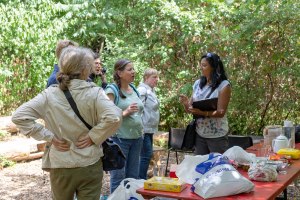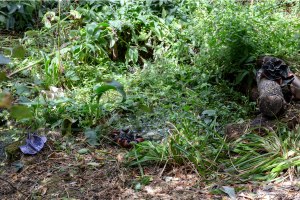A Visit to Phytology and Bethnal Green Nature Reserve – 28thJuly 2018
This was the first of the multi-disciplinary “Art and Environment Study Days: Ideas from the Soil “offered by OCA tutors Melissa Thompson and Dan Robinson.
The objective was to:-
- Meet other creative people and share ideas
- Think about nature’s influence on art and design whilst recording the experiences
- Improve and experiment with drawing/photography
- Have fun with tools and materials, try alternative ways of using a tool
- Challenge creative thinking; generate ideas and new ways of working
What interested me was that the project is a collaboration between a group of artists and Teesdale & Hollybush Tenants and Residents Association which had been taking care of the land since the late 1990s. the aim being to protect the space, educate the public about home grown food and medicine and so use these programmes and artistic projects to demonstrate the ecological value of retaining the land rather than using it for building at the time of a housing crisis. Phytology itself is part of Nomad Projects, “an independent commissioning foundation that provides support for contemporary artists to develop socially relevant work within the public realm”. There is more about their projects here
Information about Bethnal Green Nature Reserve, its history and its trees and shrubs can be found here and the Phytology medicinal garden can be found here
The Day
The small nature reserve is hidden away in Bethnal Green and protected by railings around the perimeter which are slowly being entwined by green growth. The gate is open and I step inside to a wonderful smell of loamy soil as the leaves dance on the trees to sing a welcome. My overwhelming impression was of light, airy greenness with its delicate overarching canopy.
There were eight of us in the group to be welcomed by Melissa and Dan.
During introductions and initial discussions, I was aware of not only a shared interest in the environment and landscape but also a desire by everyone to collaborate at a multi-disciplinary level and learn from other artists which is so reassuring. Following this Michael Smythe, who established Nomad Projects in 2009, came to say hello and, after we’d been reminded that some liquid refreshment had been brought for us – some soft, smooth Mallow tea (we’d been so busy talking to each other that we hadn’t noticed!), Michael gave us a brief talk about this particular project and then gave us a tour – bypassing a group in another small clearing who were learning about the use of medicinal plants – ending up at the garden. It’s quite small actually but, again, with that sense of slight wildness, with plants not quite contained as they butted up against each other. The Phytology site informs that there are twenty-three different medicinal plants. I knew about dandelion and burdock, remembered eating ‘bread and cheese’ hawthorn leaves; am quite often stung by common nettles (thank goodness I know about the value of dock leaves), but hadn’t heard about most of the others. I still can’t quite work out how the marsh mallow root was formally used to create marshmallows – those soft, fluffy confections which are often covered in chocolate.
We then returned to our own space to begin the first set of exercises – five of us chose a slip which gave instructions to follow, all of which encouraged us to observe our environment in different ways. The first set of exercises was about observing growth noticing, documenting and finding relationships with non-human beings in the garden – intervening and interacting. My major realisation was that although I enjoy being in green spaces I’m not good at learning or remembering the names of plants and I discussed with another member of the group how different this is when meeting people – we want to know all about them and knowing their name is important. This made me think about the naming of things, and I mused how much knowing the names of plants might make we humans feel more connected with them as an essential part of our environment.
Actually, this Nature Reserve is one of those places like Dr Who’s telephone box – it takes up a relatively small area yet somehow expands when you’re inside it due to the clever way in which the paths have been created to encourage wandering, explore, discover small artist installations scattered around, bird boxes, small pools. Occasionally I could see fleeting figures flitting behind whispering, leafy screens. Feeling out of time somehow, almost like I’d wandered into a fairy glade – a Midsummer’s Day dream offering some natural healing.
Then it was time for lunch and we joined in with a wonderful shared lunch (held every Saturday from 26thMay to 1stSeptember) cooked and prepared by local residents, using fresh ingredients from the medicine garden. We were joined by Nick Bridge, Writer in Residence who visits weekly Secluding oneself away for spiritual refreshment has been known for centuries and what an opportunity to do this by spending some time as a writer in residence within the nature reserve. A small space which is the writer’s hut offers Nick a time for reflection and writing and his thoughts and exchange of letters with like-minded contemporaries will hopefully appear in book form at some time in the future. Nick talked about the way he is using his time away from his everyday high-powered job to reflect upon the meaning and value of Phytology at a time when climate change and environmental issues occupy his thoughts.
After lunch Nick joined us in the second set of exercises – again focussing us on interacting with the trees and plants. I carried on observing quietly, sometimes taking photographs or creating short videos; noticing more of the smaller installations, almost hidden away, some nestling by the small ponds installed to support the newt, toad, frog, insect and bat population. I went to the plant garden again and stroked the soft leaves of the marsh mallow plant. On the way back for the group de-briefing I visited the writers hut and had a look at a collection of some of the ‘found’ objects discovered in the nature reserve by the artist Ellie Doney when she spent the summer of 2017 as an artist in residence there .
Thoughts
In many respects it’s difficult to summarise the experience itself because I felt so immersed in the environment. It’s the kind of green space I would love to be able to visit every day. In fact the nature reserve isn’t opened to visitors every day because, being a relatively small space the garden needs time to recover and it closes completely to visitors for some months. I certainly wondered about the smallness of the medicinal plant area. Local residents can go and collect leaves etc for their own use and I couldn’t imagine the plants could cope with being picked too often. I also keep reminding myself that, although the nature reserve itself has been there for several years it is now a partnership with an education and artists project. It really is an on-going creation, almost like an out-of-time capsule with its own staff and utilising the talents of artists writers and geographers who intern there or spend time ‘in-residence’. I think it must be this sense of movement, flow and newness that helps to keep it fresh, green and refreshing.
After hearing Nick Bridge talk I’ve also pondered again on the dissonance in the daily lives of many of us – that living in boxes, working in environments that stress and exhaust us and then escaping to nature or other pursuits that we need to keep us in tune with other aspects of ourselves. How wonderful to think of being one of the staff at the Nature Reserve and Phytology or to build a more holistic lifestyle for ourselves. Normally when I go up to London for Exhibition visits and such I come back feeling very tired, weary of the hard pavements, noise and thick air of the underground. This time, though, I came home feeling relaxed, revived, refreshed and invigorated.
Here’s a video I put together from the short ones I created during the day. I hope it gives an impression of what it’s like there.
I’m so pleased as well to have been able to participate in one of these Art & Environment Study Days, to be reminded that there are other students within OCA from other disciplines who want to collaborate and exchange ideas and to know that Melissa and Dan want to keep the momentum going and have already set up a Google Drive folder on the OCA student website for us to share work and thoughts.
References
http://bgnrt.org
http://elliedoney.co.uk/work/phytology
http://nomadprojects.org/project/
https://phytology.org.uk
https://phytology.org.uk/projects/letters-shed-nick-bridge/











I love the very sensitively put together video of the environment with the occasional white butterfly flitting through it just like the people are doing but on a bigger scale. I really like the angle of your main photo – very sharp & interesting photos throughout, Catherine. Great summing up and reflections on what the day meant to you.
LikeLike
Thanks Anna. I’m still digesting the experience really, pondering some new ideas and waiting to see what results. It was good to spend the day with you as well.
LikeLike
What an amazing experience Catherine. Your video & images convey the ethos of the place perfectly.
LikeLike
I’m pleased you got a sense of it Judy. It’s quite ethereal really.
LikeLiked by 1 person
This looks great. I’m glad you had a such a wonderful time.
LikeLike
It was so interesting Sarah-Jane. Will tell you more if there’s time tomorrow.
LikeLike
Thanks for this and all your background research to the project too! I was watching the video and some white butterflies were flying past the back of the screen too… so sites easily travel across, repeat. Yes: it would be lovely if this translates into a repeat/longer project context…
LikeLike
Pingback: Study event review: Art & environment weekend. Day 1. - #weareoca
Pingback: Performer and Participant: Tate Modern 8th October 2018 | Portraying Landscape